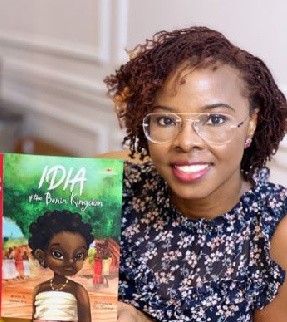Benin Kingdom, located in what is now southern Nigeria, was one of the most highly developed states in Africa when it fell in 1897 following the destruction of its capital, Benin City, by the British.
Britain’s punitive expedition did not only lead to the deaths of gallant chiefs but it also took away various works of art including Ivory and bronze works. Today, one of the most famous artworks from the kingdom is Queen Idia’s mask, with versions housed at the Metropolitan Museum of Art, British Museum, and Linden Museum.
Considered the first Queen Mother of Benin, Idia was the mother of Esigie, the Oba (king) of Benin between 1504 and 1550. A great warrior and wise queen, she is believed to have saved the entire kingdom of Benin in a time of war and turmoil.
Thanks to Nigerian-Canadian author Ekiuwa Aire, children can now relive the highly revered Nigerian queen’s story from a real African perspective.
The colorfully depicted children’s book, Idia of the Benin Kingdom, is among a wave of new African-centric children’s books aimed at teaching Black children about their culture and history through the eyes of characters who look just like them, author Aire says.
The 37-year-old mother of two girls tells Face2Face Africa what inspired her to write the book and more:
1. Can you tell us a little bit about your new book?
Idia of the Benin Kingdom introduces young readers to the story of Queen Idia of the ancient Kingdom of Benin. She played an essential role during the reign of her son, Esigie, who ruled Benin from 1504-1550. The book takes readers on a beautifully illustrated journey to the 1500s in ancient Africa. Readers are captivated as they watch Idia transform herself from the young and curious daughter of a village warrior to becoming the Queen of the Kingdom of Benin. This book also teaches about perseverance, hard work, devotion, kindness, generosity, and love, it speaks to how we can be inspired to strive for our goals as long as we believe in them. Idia of the Benin Kingdom is a precious storybook that empowers a young girl to create a vision of who she wants to be as she creates limitless possibilities for her future.
2. What inspired you to write this book?
A few years ago, I noticed the lack of diversity in the children’s book industry. Specifically regarding children’s books about African history. While there are a few books on black history, there was literally nothing on African history. This was where the idea for my book was born.
3. Kindly tell us about your writing process? What was a typical writing day for you?
Step 1 for me is research. I look into a character and document reasons for success (why I should write about them) traits, qualities, home life, surroundings. Based on this research, I determine what the key learnings/takeaways from my book should be. That is, what do I want kids to learn from this character? Then I develop a synopsis. This is a rough outline of the story. The character’s traits and the key takeaway form what I put into the storyline. From here, I prune the story and fact check what is left behind. Next, I start working on the illustrations. For each page/scene, I provide the illustrator with written guidelines of what should be included. I provide visual guides when I can to assist the illustrator. The illustrations typically take 3-4 months to complete. While this is going on, I’m sending the book in for developmental and final edits. I also start working on the fact pages at this time. The fact pages are where I store key information about character/culture/story that do not make it into my story line.
4. What do you think children can learn from this book?
The most important take away from this book is that Queen Idia existed. This book is not all fiction. It is based on reality. With this book, kids learn that there once lived a Queen who was once a persistent little girl who followed her dreams.
5. What do you hope to achieve with this book?
The goals for my book were two-fold.
1. To write a culturally accurate book
2. To write a book that will be accepted, understood, and enjoyed by other cultures and not just the African community
6. Our Ancestories is the publishing company you started ahead of Idia’s narrative. Can you tell us why you chose to self publish the book?
I decided to self publish because I didn’t want to risk exposing my book to biases that may be present in the current media gatekeepers. I didn’t want to stop at the manuscript. I wanted to own every aspect of how the story was told. From the illustrations to the marketing.
7. Kindly tell us about your childhood in Benin. How did it influence Idia’s narrative?
Growing up in Benin was a culturally enriching experience. In Benin, the monarchy has a huge influence on the people. Traditions are passed down from one generation to the next. Within the bigger tribal culture, there are smaller traditions and practices within smaller family circles. The way one family greets good morning tells of their lineage. I’m from the layeru family. This means, when I see my parents in the morning, I kneel and say “Layeru”. Other families may say “Lagba” or “Laigie”. This Facebook post has a comprehensive list: https://www.facebook.com/269072593868582/posts/these-are-complete-morning-greetings-amongst-the-binisfind-yours-labo-osuan-enog/391421278300379/
Cultural values in Benin determine morning greetings, food, traditional dressing, religion, and burial rites.
In the November – January period, there are celebrations and festivals from ancient times that still take place. One of my favourite memories from Benin is of receiving the Ewere festival dancers. Ugie Ewere is the festival of the Ewere leaves, this leaf symbolizes good luck, joy, and prosperity in the Benin Kingdom. Traditional dancers go out to the forest early morning after the Igue festival to pick Ewere leaves. They take these peaceful leaves and dance from house to house to give distributing them to households as a thanksgiving to God and to wish these households well in the coming new year.
The culture in Benin surrounds all who live there. The city is small. It consists of the Oba’s Palace, a museum, art galleries, Igun street, and a uniquely placed roundabout in the center of the city called Ring Road. Every major road in the city is connected to Ring Road. Replica’s of Queen Idia’s mask can be found all over the city. On t-shirts, mugs, hats, buildings. There is a school in Benin named after Queen Idia, my sister attended that school. So Idia is someone that I was aware of from a very young age.
8. What’s next after Idia and where can readers find your books?
The Idia book can be purchased here: https://our-ancestories.com/product/idia-of-the-benin-kingdom-childrens-book/
Next, I’m writing a book on Queen Nzinga of Ndongo and Matamba.
9. Who are the writers you most admire?
I admire Chimamanda Ngozi Adichie because her voice is so powerful. I also admire Vashti Harrison because of the exposure and awareness she has brought to African American history through her books
10. What changes would you like to see in the African literary landscape?
It will be great to see more engaging and good quality African-centric books for kids. We’ve made some progress in recent years in this regard, but we still have a ways to go to catch up with the rest of the world.










Discussion about this post